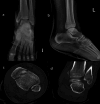Patterns of Ankle Fractures Based on Radiographs and CT Images of 1000 Consecutive Patients
- PMID: 38420522
- PMCID: PMC10898796
- DOI: 10.22038/ABJS.2023.71767.3350
Patterns of Ankle Fractures Based on Radiographs and CT Images of 1000 Consecutive Patients
Abstract
Objectives: The knowledge of different types of ankle fractures based on plain radiographs and computed tomography (CT) images can help improve patients' management.
Methods: This cross-sectional study assessed the plain radiographs and CT images of 1,000 consecutive patients observed in an emergency department between March 2015 and March 2020. Fractures were labeled as uni-, bi-, or trimalleolar. Malleolar fractures were classified into medial, lateral, and posterior ones based on Herscovici, Danis-Weber, and Mason and Molloy classifications, respectively. Bi- and trimalleolar fractures, on the other hand, were categorized according to the Lauge-Hansen classification.
Results: This study included 1,000 patients with 1,003 ankle fractures. Of them, 901 were adults (mean±SD age: 41.6±16.7, male: 567 [62.9%]) with 904 fractures. In total, 53% of adult patients were 18 to 39 years old. Considering unilateral ankle fractures, the medial malleolar fracture was the most common unimalleolar fracture (62.6%), with Herscovici C being the most frequent subtype (65.3%). On the other hand, the most common type of lateral malleolar fracture was Danis-Weber type B (65.5%). There were also 209 (23.3%) bimalleolar and 114 (12.7%) trimalleolar fractures, 5.8% (16 fractures) of which could not be classified based on the Lauge-Hansen classification. Unimalleolar fractures were also observed in 87 (87.9%) children, with the medial malleolar fracture being the most common type (89.7%).
Conclusion: Medial malleolar fractures were the most frequent malleoli in patients observed in the emergency department under study. Among bi- and trimalleolar ankle fractures, supination-external rotation and pronation-external rotation injuries were the most common patterns. The Lauge-Hansen classification was not applicable in 5.8% of bi- and trimalleolar fractures.
Keywords: Ankle; Ankle fracture; Bimalleolar ankle fracture; CT; Radiograph; Trimalleolar ankle fracture; Unimalleolar ankle fracture.
2024 © BY THE ARCHIVES OF BONE AND JOINT SURGERY.
Conflict of interest statement
None
Figures





References
-
- Elsoe R, Ostgaard SE, Larsen P. Population-based epidemiology of 9767 ankle fractures. Foot Ankle Surg. 2018;24(1):34–39. - PubMed
-
- Shibuya N, Davis ML, Jupiter DC. Epidemiology of foot and ankle fractures in the United States: an analysis of the National Trauma Data Bank (2007 to 2011) J Foot Ankle Surg. 2014;53(5):606–608. - PubMed
-
- Scheer RC, Newman JM, Zhou JJ, et al. Ankle Fracture Epidemiology in the United States: Patient-Related Trends and Mechanisms of Injury. J Foot Ankle Surg. 2020;59(3):479–483. - PubMed
LinkOut - more resources
Full Text Sources
